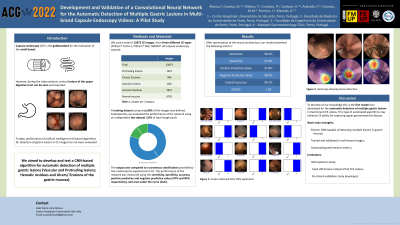Back


Poster Session E - Tuesday Afternoon
Category: General Endoscopy
E0277 - Development and Validation of a Convolutional Neural Network for the Automatic Detection of Multiple Gastric Lesions in Multi-brand Capsule Endoscopy Videos: A Pilot Study
Tuesday, October 25, 2022
3:00 PM – 5:00 PM ET
Location: Crown Ballroom

Has Audio

Joao Afonso, MD
Centro Hospitalar de São João
Porto, Porto, Portugal
Presenting Author(s)
Award: Presidential Poster Award
Joao Afonso, MD1, Miguel Mascarenhas, MD2, Tiago Ribeiro, MD2, Pedro Cardoso, MD2, Ana Andrade, MD2, João Ferreira, PhD3, Hélder Cardoso, MD2, Guilherme Macedo, MD, PhD2
1Centro Hospitalar de São João, Porto, Porto, Portugal; 2Centro Hospitalar de S. João, Porto, Porto, Portugal; 3FEUP: Faculdade de Engenharia da Universidade do Porto, Porto, Porto, Portugal
Introduction: Capsule endoscopy (CE) is the goldstandard for the evaluation of the small bowel. However, during the video analysis, various lesions of the upper digestive tract can be seen and reported. To date, performance of artificial intelligence (AI) based algorithms for detection of gastric lesions in CE images has not been evaluated.
We aimed to develop and test a CNN-based algorithm for automatic detection of multiple gastric lesions (Vascular and Protruding lesions; Hematic residues and Ulcers/ Erosions of the gastric mucosa).
Methods: We used a total of 12873 CE images, from three different CE types (PillCam® Crohn’s; PillCam® SB3; OMOM® HD capsule endoscopy system) for the construction of the CNN: 1407 from protruding lesions; 994 from ulcers and erosions; 840 from vascular lesions and 2851 from hematic residues. The remaining images were from normal mucosa. A training dataset comprising 80% of the images was defined. Subsequently, we evaluated the performance of the network using an independent test dataset (20% of total image pool). The output was compared to a consensus classification provided by two endoscopists experienced in CE. The performance of the network was measured using the sensitivity, specificity, accuracy, positive predictive and negative predictive values (PPV and NPV, respectively), and area under the curve (AUC).
Results: After optimization of the neural architecture, our model was able to detect detected gastric lesions with a sensitivity, specificity, PPV and NPV of 98.4%, 97.9%, 97.8% and 98.5%, respectively. The algorithm had an overall accuracy of 98.1%. The AUC was 1.00.
The output obtained after the CNN application can be seen in Figure 1.
Discussion: To the best of our knowledge this is the first model ever developed for the automatic detection of multiple gastric lesions in multi-brand CE videos. This type of automated algorithms may enhance CE ability for exploring upper gastrointestinal disease.

Disclosures:
Joao Afonso, MD1, Miguel Mascarenhas, MD2, Tiago Ribeiro, MD2, Pedro Cardoso, MD2, Ana Andrade, MD2, João Ferreira, PhD3, Hélder Cardoso, MD2, Guilherme Macedo, MD, PhD2. E0277 - Development and Validation of a Convolutional Neural Network for the Automatic Detection of Multiple Gastric Lesions in Multi-brand Capsule Endoscopy Videos: A Pilot Study, ACG 2022 Annual Scientific Meeting Abstracts. Charlotte, NC: American College of Gastroenterology.
Joao Afonso, MD1, Miguel Mascarenhas, MD2, Tiago Ribeiro, MD2, Pedro Cardoso, MD2, Ana Andrade, MD2, João Ferreira, PhD3, Hélder Cardoso, MD2, Guilherme Macedo, MD, PhD2
1Centro Hospitalar de São João, Porto, Porto, Portugal; 2Centro Hospitalar de S. João, Porto, Porto, Portugal; 3FEUP: Faculdade de Engenharia da Universidade do Porto, Porto, Porto, Portugal
Introduction: Capsule endoscopy (CE) is the goldstandard for the evaluation of the small bowel. However, during the video analysis, various lesions of the upper digestive tract can be seen and reported. To date, performance of artificial intelligence (AI) based algorithms for detection of gastric lesions in CE images has not been evaluated.
We aimed to develop and test a CNN-based algorithm for automatic detection of multiple gastric lesions (Vascular and Protruding lesions; Hematic residues and Ulcers/ Erosions of the gastric mucosa).
Methods: We used a total of 12873 CE images, from three different CE types (PillCam® Crohn’s; PillCam® SB3; OMOM® HD capsule endoscopy system) for the construction of the CNN: 1407 from protruding lesions; 994 from ulcers and erosions; 840 from vascular lesions and 2851 from hematic residues. The remaining images were from normal mucosa. A training dataset comprising 80% of the images was defined. Subsequently, we evaluated the performance of the network using an independent test dataset (20% of total image pool). The output was compared to a consensus classification provided by two endoscopists experienced in CE. The performance of the network was measured using the sensitivity, specificity, accuracy, positive predictive and negative predictive values (PPV and NPV, respectively), and area under the curve (AUC).
Results: After optimization of the neural architecture, our model was able to detect detected gastric lesions with a sensitivity, specificity, PPV and NPV of 98.4%, 97.9%, 97.8% and 98.5%, respectively. The algorithm had an overall accuracy of 98.1%. The AUC was 1.00.
The output obtained after the CNN application can be seen in Figure 1.
Discussion: To the best of our knowledge this is the first model ever developed for the automatic detection of multiple gastric lesions in multi-brand CE videos. This type of automated algorithms may enhance CE ability for exploring upper gastrointestinal disease.

Figure: Figure 1 - Output obtained after CNN application
Disclosures:
Joao Afonso indicated no relevant financial relationships.
Miguel Mascarenhas indicated no relevant financial relationships.
Tiago Ribeiro indicated no relevant financial relationships.
Pedro Cardoso indicated no relevant financial relationships.
Ana Andrade indicated no relevant financial relationships.
João Ferreira indicated no relevant financial relationships.
Hélder Cardoso indicated no relevant financial relationships.
Guilherme Macedo indicated no relevant financial relationships.
Joao Afonso, MD1, Miguel Mascarenhas, MD2, Tiago Ribeiro, MD2, Pedro Cardoso, MD2, Ana Andrade, MD2, João Ferreira, PhD3, Hélder Cardoso, MD2, Guilherme Macedo, MD, PhD2. E0277 - Development and Validation of a Convolutional Neural Network for the Automatic Detection of Multiple Gastric Lesions in Multi-brand Capsule Endoscopy Videos: A Pilot Study, ACG 2022 Annual Scientific Meeting Abstracts. Charlotte, NC: American College of Gastroenterology.

